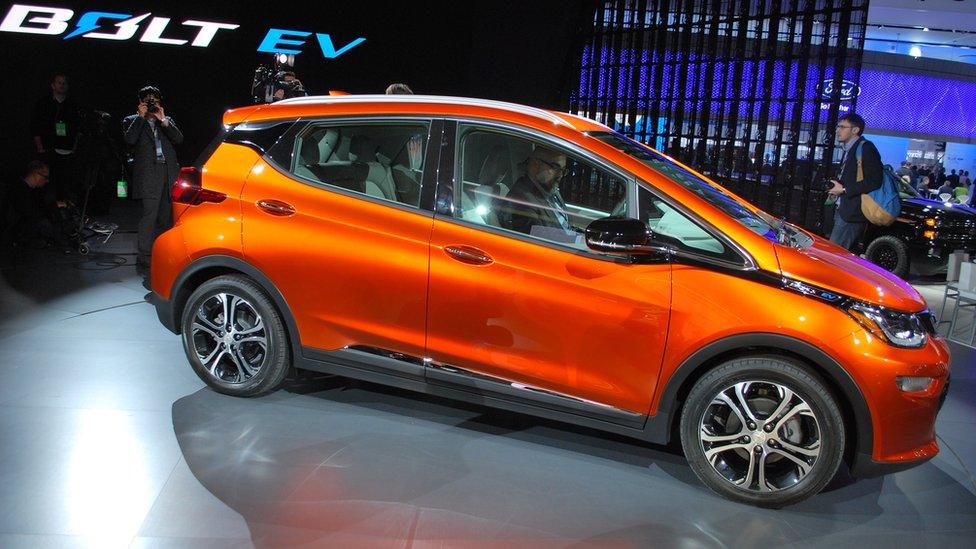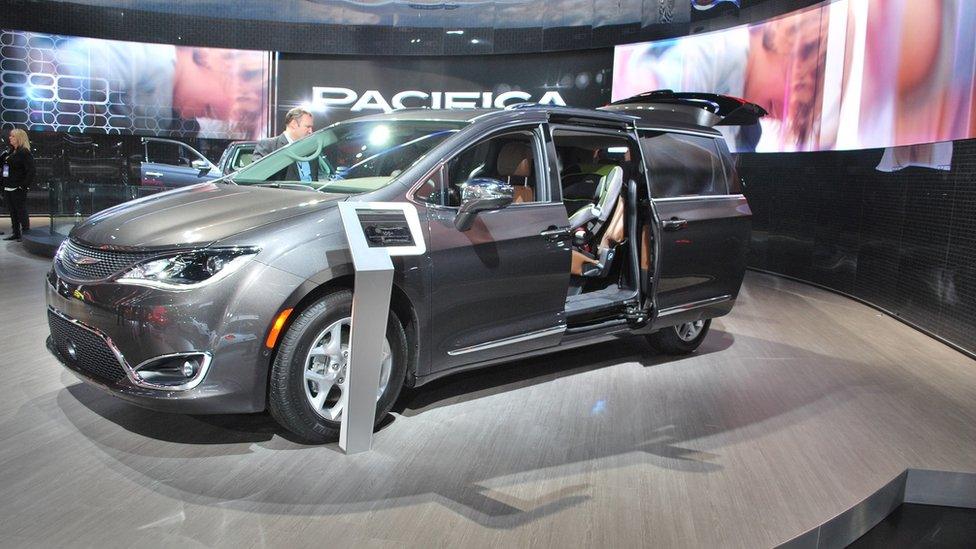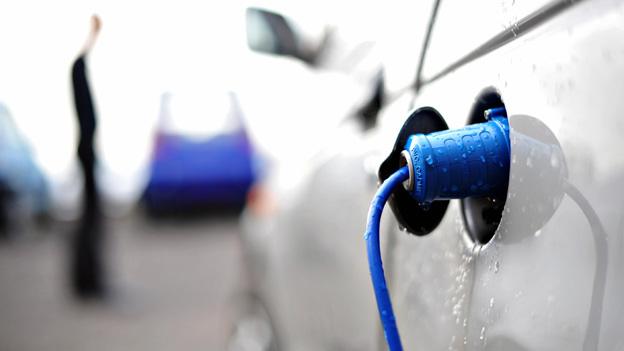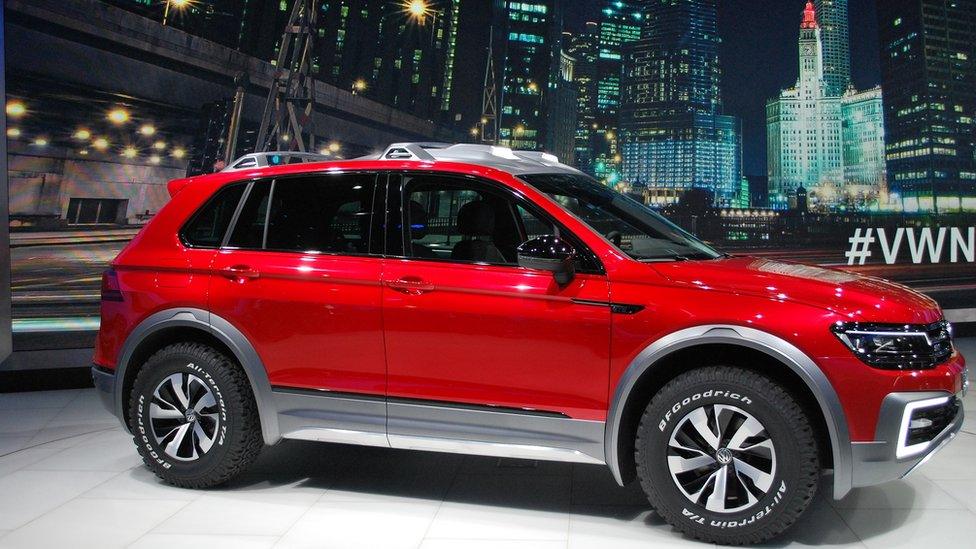Detroit Motor Show: Oil slide won't halt electric future
- Published

The Chevy Bolt can go 200 miles when the electric battery is fully charged
Filling up at the pump has rarely been less terrifying. A worldwide over supply has pushed the price of oil to an 11-year low.
The drop in oil - and consequently petrol - prices have helped the already booming car industry to attract even more buyers.
Yet, despite the assistance plummeting oil has offered the industry, carmakers are still setting their sights on an electric future.
Advertised as road ready, stylish and cost effective, many car brands are counting on consumers' worries about the environment, or desire for convenience, to push the electric vehicle market forward.
The Chevy Bolt is one of the cars leading the way in that field.
General Motors unveiled the concept car at the Consumer Electric Show, in Las Vegas, but are touting the production model at this week's motor show in Detroit.
Rideshare appeal
The Bolt will cost $30,000 (£20,622) with a tax credit from the US government, and GM says the car will go into production at the end of this year.
The Bolt is very much designed for urban living. It has a smaller frame than many cars, which the designers say will make it easier to manoeuvre through traffic and fit into tight parking spaces.
The car can go approximately 200 miles on a full battery, which is close to the average range of half a tank of petrol in the US.

The hybrid Pacifica can go 30 miles on its electric engine before switching to petrol.
It does take about nine hours of charging to get the battery from empty to full. The average American only drives 40 miles a day, though. So, GM is quick to point out that recharging will typically only take a few hours.
"A quarter of the battery takes about two hours to charge, so it's about the same amount of time as your smart phone," says Darin Gesse, product manager for the Bolt.
The Bolt was also designed to appeal to a growing number of rideshare drivers and passengers.
"The Uber environment, the stop-and-go, the Lyft environment, that is ideal for a vehicle like this," says Mr Gesse, in reference to taxi-booking apps Uber and Lyft.
Stopping and starting - typical of urban driving - also adds to the appeal of electric cars, which use regenerative breaking to "top up" the power, and get back 95% of the energy used to start the car.
According to Mr Gesse the interior of the Bolt was designed with ridesharing in mind. The backseat can fit three passengers, and also has no foot wells to make it easier to climb in and out.
The company may be onto something.
Ride-hailing services such as Lyft and Uber like to suggest that they lead to fewer numbers of cars on the road, and thus a cut in emissions.
Environmentally-conscious passengers, particularly on America's west coast, are likely to be supportive of further efforts to cut emissions.

General Motors announced last week that it made a $500m (£344m) investment in Lyft to help develop a fleet of driverless vehicles. The US manufacturer has not said whether it will join forces with Lyft to help drivers buy or lease the Bolt.
Hybrid vs full electric
As well as developing all-electric vehicles, manufacturers continue to make advances with hybrid petrol/electric cars.
Volkswagen - whose green credentials have been damaged by the scandal involving its diesel cars - premiered the Tiguan GTE Active concept, a hybrid sports utility vehicle (SUV), at the Detroit motor show.
The Tiguan is a nod to the company's need to offer SUVs to meet North American demand, while the plug-in electric engine is a chance for VW to take a second stab at wooing environmentally inclined drivers.
The lithium battery can take the car 20 miles before it switches to a traditional engine that can get the car a further 560 miles.
"I think electric cars will play a really important role worldwide," says Dr Herbert Diess, head of the board of management that looks after the Volkswagen brand.
Demand from America's west coast and environmental policies in China are helping to increase electric cars sales, says Dr Diess.
The Tiguan was in the works before VW's use of "defeat devices" to hide emission levels was revealed, and will not be available in the US until 2017.
Meanwhile, Chrysler unveiled its new minivan - Pacifica - that comes in a hybrid plug-in version. The car is the newest spin on Chrysler's Town & Country luxury passenger minivan.

The Tiguan GTE Active will go on sale in the US in 2017
The hybrid Pacifica can go 30 miles on its electric engine before switching to petrol.
Chrysler says it decided to launch the Pacifica as a hybrid because people-movers - used typically for many short trips per day - were "ideally suited" to rely on electric engines.
Re-powering
Carmakers are having to emphasise the other benefits of electric vehicles, such as saving time and skipping the inconvenience of filling the tank.
"Here in Michigan, and in the north, I've yet to discover a heated gas station," says Mr Gesse on a day when Detroit's temperature reached -10C.
GM hopes convincing people of the ease of re-powering their cars at home will encourage more sales of the new Bolt and their existing hybrid the Volt.
It is likely that the tech-focused markets and environmentally conscious drivers will, for the time being, make up the bulk of the entirely electric market.
With emissions standards changing however, more and more car companies are aware that moving to electric is the way forward.